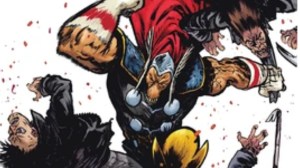
Having worked my fair share of retail jobs in the American consumer institution that is the shopping mall, I can tell you there have been many times I’ve wondered how a mall might appear as a community in the event of catastrophe. It’s a concept that writers Michael Moreci and Gary Dauberman have clearly considered as well, so much so that they’ve turned it into a comic book. While the idea of a post-apocalyptic mall society is a novel one, Mall #1 is a concept that feels like maybe it’s time has already passed.
Videos by ComicBook.com
Mall #1 delivers the gist of how his apocalypse began right away. The world ends due to climate change, but that was apparently generations ago. Those who survived are the ones who took refuge in the mall and that’s where things start to unravel for the overall premise of Mall. Our narrator tells us that malls were “the social, spiritual, and shopping meccas” of life and while that’s not exactly wrong, it’s not exactly accurate in our current moment. Malls have found themselves slipping out of fashion in recent years which makes the issue’s next point—that malls endure, making them a perfect place to ride out the apocalypse—moot. In many cities across America, malls are shutting down (and even being demolished) with near-regularity these days. Already Mall #1 doesn’t quite seem to make sense and we haven’t arrived at the story yet.

If you get past all of that, the narrator speaks as someone generations removed from the end of the world, then the current action of the story will probably lose you—and I don’t mean the creepy opening action sequence involving a gang of oddly masked figures and implied infanticide. The story quickly tries to set itself up as a Mad Max meets Mallrats pitch and as a critique on consumer culture. In Mall, the factions name themselves after their “favorite” retailers. Our protagonist, Andre, comes from the “Gacy’s” faction and it’s not too much of a stretch to guess what retailer they’re mapping that name onto. Each faction also appears to take on elements of the retailer’s image. There’s a group that looks like walking caricatures of Hot Topic and others appear permanently clothed in old food court uniforms, their identities tied to hot dogs and pretzels of a long gone culture.

Unfortunately, beyond the interesting visual interpretation of consumer culture mashed up with an apocalyptic setting, there’s not much to the story that makes sense. Somehow, Andre looks like he killed the leader of a rival faction and that leader’s daughter wants him released to the Beyond—meaning the world outside the mall that is a supposedly irradiated wasteland inhabited by monsters—but he wants to prove that he didn’t do it. Most of the issue is spent with Andre running from place to place and seeking help, but after being often turned away, Andre refuses help when it’s finally offered. He refuses, at least, until he’s saved from the Beyond in the nick of time by a mysterious benefactor who whisks him into another place that is supposedly a dangerous mess—the bowels of the mall. Okay?
Ultimately, Mall #1 doesn’t seem to know what kind of story it wants to tell. Is it commentary on climate change? Is it a satire of consumer culture? Is it just meant to be straight up horror? It’s not clear with Mall #1. What is clear is that this comic is going to have to do serious work to find its footing. There’s sadly not much in Mall #1 to instill any real sense of attachment to the story. It may be a book about the end of the world, but whatever world that ended doesn’t really feel like our own, making this mall one you might not want to visit.
Published by Vault Comics
On August 28, 2019
Written by Michael Moreci and Gary Dauberman
Art by Zak Hartong
Colors by Addison Duke
Letters by Jim Campbell








